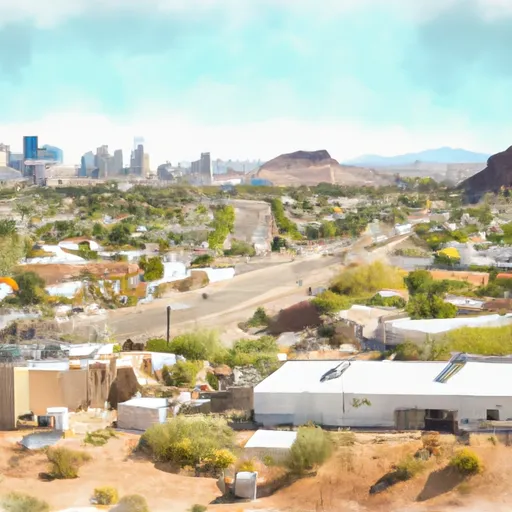-
 Snoflo Premium
Snoflo Premium
Get unlimited access to all our content
With no Ad interruptions! - Start Your Free Trial Login with existing account
Saint-David
Eden Index
Climate
8.9
•
Recreation
5.0
•
Community
1.7
•
Safeguard
5.7/10

Saint David, Arizona is a small community located in the southeastern part of the state. Known for its beautiful landscapes and ample outdoor recreation opportunities, it attracts visitors and residents alike. Saint David experiences a warm desert climate, characterized by hot summers and mild winters. Summers can get extremely hot, with temperatures often exceeding 100°F, while winters are generally mild with temperatures ranging from the mid-40s to low 60s°F.
Hydrologically, Saint David is situated in the Upper San Pedro River Basin. The area is part of a unique ecosystem, as the San Pedro River is one of the few remaining undisturbed rivers in the American Southwest. The river provides essential habitat for various bird species, making it a popular spot for birdwatching and nature enthusiasts.
Outdoor recreation opportunities in Saint David are abundant. The region offers numerous hiking and biking trails, allowing visitors to explore the stunning desert landscapes and observe the diverse flora and fauna. Additionally, the nearby Kartchner Caverns State Park offers guided cave tours, showcasing remarkable limestone formations. With its pleasant climate and breathtaking surroundings, Saint David is an ideal destination for those seeking outdoor adventure and natural beauty.
What is the Eden Index?
The Snoflo Eden Index serves as a comprehensive rating system for regions, evaluating their desirability through a holistic assessment of climate health, outdoor recreation opportunities, and natural disaster risk, acknowledging the profound impact of these factors on livability and well-being.
Climate Health Indicator (CHI): 8.9
Saint-David receives approximately
334mm of rain per year,
with humidity levels near 47%
and air temperatures averaging around
17°C.
Saint-David has a plant hardyness factor of
8, meaning
plants and agriculture in this region tend to thrive here all year round.
By considering the ideal temperature range, reliable water supplies, clean air, and stable seasonal rain or snowpacks, the Climate Health Indicator (CHI) underscores the significance of a healthy climate as the foundation for quality living.
A healthy climate is paramount for ensuring a high quality of life and livability in a region, fostering both physical well-being and environmental harmony. This can be characterized by ideal temperatures, reliable access to water supplies, clean air, and consistent seasonal rain or snowpacks.
Weather Forecast
Streamflow Conditions
San Pedro-Willcox
Area Rivers
San Pedro-Willcox
Snowpack Depths
San Pedro-Willcox
Reservoir Storage Capacity
San Pedro-Willcox
Groundwater Levels
Recreational Opportunity Index (ROI): 5.0
The Recreational Opportunity Index (ROI) recognizes the value of outdoor recreational options, such as parks, hiking trails, camping sites, and fishing spots, while acknowledging that climate plays a pivotal role in ensuring the comfort and consistency of these experiences.
Access to outdoor recreational opportunities, encompassing activities such as parks, hiking, camping, and fishing, is crucial for overall well-being, and the climate plays a pivotal role in enabling and enhancing these experiences, ensuring that individuals can engage in nature-based activities comfortably and consistently.
Camping Areas
| Campground | Campsites | Reservations | Toilets | Showers | Elevation |
|---|---|---|---|---|---|
| Garden Canyon Military - Fort Huachuca | None | 4,888 ft | |||
| Reef Townsite | 14 | 7,166 ft | |||
| Ramsey Vista | 8 | 7,433 ft | |||
| Kartchner Caverns State Park | 62 | 4,572 ft | |||
| Apache Flats Military - Fort Huachuca | None | 4,949 ft |
Nearby Ski Areas
Catastrophe Safeguard Index (CSI):
The Catastrophe Safeguard Index (CSI) recognizes that natural disaster risk, encompassing floods, fires, hurricanes, and tornadoes, can drastically affect safety and the overall appeal of an area.
The level of natural disaster risk in a region significantly affects safety and the overall livability, with climate change amplifying these risks by potentially increasing the frequency and intensity of events like floods, fires, hurricanes, and tornadoes, thereby posing substantial challenges to community resilience and well-being.
Community Resilience Indicator (CRI): 1.7
The Community Resilience Indicator (CRI) recognizes that education, healthcare, and socioeconomics are crucial to the well-being of a region. The CRI acknowledges the profound impact of these elements on residents' overall quality of life. By evaluating educational resources, healthcare accessibility, and economic inclusivity, the index captures the essential aspects that contribute to a thriving community, fostering resident satisfaction, equity, and social cohesion.

